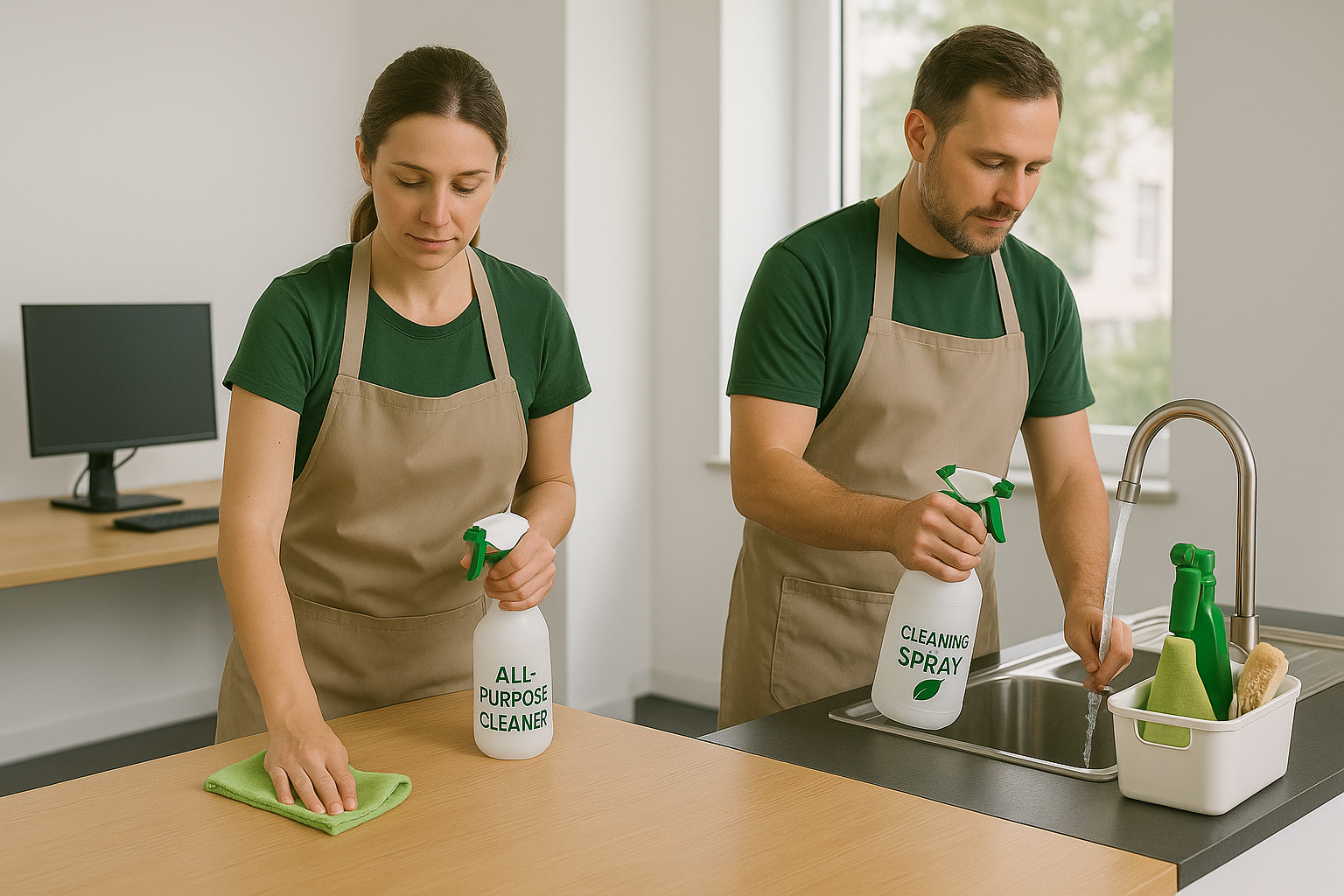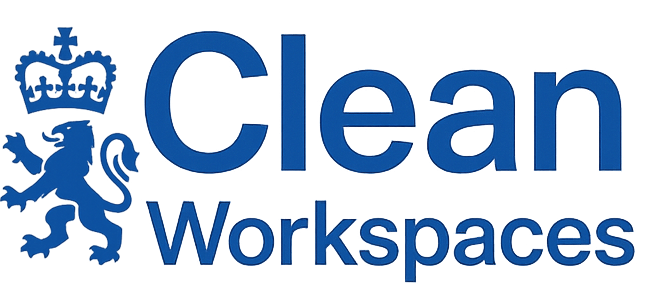Sustainable Cleaning
Balancing efficacy and environmental impact in modern workplace hygiene practices

The cleaning industry is experiencing a fundamental transformation as organizations increasingly recognize the importance of balancing effective hygiene with environmental responsibility. This shift goes beyond simple "green washing" to encompass comprehensive approaches that maintain high cleanliness standards while minimizing ecological impact across the entire cleaning lifecycle.
The Environmental Impact of Traditional Cleaning
Conventional cleaning approaches create environmental challenges through multiple pathways:
- Chemical pollution: Harsh cleaning compounds entering waterways and ecosystems
- Air quality degradation: Volatile organic compounds (VOCs) affecting indoor and outdoor air
- Resource intensity: High water and energy consumption in product manufacturing and usage
- Packaging waste: Single-use plastic containers contributing to solid waste streams
- Carbon footprint: Transportation and manufacturing emissions throughout the supply chain
- Human health impacts: Exposure risks to cleaning staff and building occupants
According to data from the Sustainability Exchange, traditional cleaning operations typically account for 10-15% of a commercial building's total water consumption and can contribute significantly to waste generation, with cleaning chemical containers representing up to 30% of facility plastic waste.
The Business Case for Sustainable Cleaning
Sustainable cleaning practices deliver multiple organizational benefits beyond environmental protection:
Financial Benefits
- • Reduced product costs: Concentrate systems and efficient dispensing
- • Lower water consumption: Microfiber and low-moisture systems
- • Energy savings: Cold-water effective formulations
- • Waste disposal savings: Reduced packaging and chemical waste
Health & Productivity Improvements
- • Improved indoor air quality: Fewer respiratory irritants
- • Reduced chemical exposure: Safer workplace environment
- • Lower absenteeism: Fewer chemical sensitivity reactions
- • Enhanced cognitive function: Better air quality supporting performance
Reputation & Compliance
- • Enhanced corporate image: Demonstrable sustainability commitment
- • Certification requirements: Supporting BREEAM, LEED, and other standards
- • Regulatory compliance: Meeting evolving environmental regulations
- • Occupant satisfaction: Meeting stakeholder environmental expectations
Risk Reduction
- • Fewer hazardous materials: Reduced storage and handling risks
- • Improved safety profile: Lower incident potential with safer alternatives
- • Simplified compliance: Fewer regulated substances to manage
- • Enhanced business continuity: Less dependency on restricted chemicals
According to our sustainable cleaning economic analysis, organizations implementing comprehensive sustainable cleaning programs typically see a return on investment within 12-18 months, with ongoing savings of 15-30% compared to conventional approaches.
Beyond Cost Considerations
While initial product costs for sustainable cleaning supplies may sometimes be higher than conventional alternatives, the total cost of ownership is typically lower when factoring in reduced water and energy usage, lower disposal costs, decreased absenteeism, and enhanced building longevity from less harsh chemical exposure.
Sustainable Cleaning Product Selection
Evaluating cleaning products for sustainability requires a comprehensive assessment approach:
Key Criteria for Product Evaluation
| Criterion | What to Look For | Why It Matters |
|---|---|---|
| Chemical Composition | Plant-based ingredients, biodegradable formulations, absence of known harmful compounds | Reduces ecological toxicity and workplace exposure risks |
| Concentration & Efficiency | High-concentration formulas, precise dilution systems, effective at cold temperatures | Minimizes packaging waste, reduces transportation impacts, saves energy |
| Packaging | Recycled materials, reduced plastic content, recyclable containers, refill options | Decreases waste generation and resource consumption |
| Manufacturing Process | Efficient production, renewable energy usage, waste reduction practices | Addresses upstream environmental impacts in the supply chain |
| Performance Efficacy | Demonstrated cleaning effectiveness in independent testing | Ensures sustainability doesn't compromise cleaning quality |
Credible Certification Programs
Several established certification programs can guide sustainable product selection:
- EU Ecolabel: European Union certification for reduced environmental impact across product lifecycle
- Nordic Swan: Rigorous Scandinavian eco-label with comprehensive criteria
- Cradle to Cradle: Holistic certification evaluating material health, recyclability, and manufacturing processes
- Green Seal: Independent certification focusing on both environmental impact and performance
- AISE Charter for Sustainable Cleaning: Industry initiative verifying sustainable manufacturing processes
These certifications provide third-party verification of sustainability claims, helping organizations avoid "greenwashing" when selecting products. For detailed product recommendations, see our eco-friendly cleaning supplies guide, which provides specific product evaluations.
Sustainable Cleaning Equipment & Methods
Product selection represents only one aspect of sustainable cleaning. Equipment choices and methodologies significantly impact overall environmental performance:
Water and Energy Efficient Equipment
- Microfiber systems: Reusable cloths and mops that dramatically reduce water and chemical usage
- Battery-powered equipment: Modern lithium-ion systems replacing corded machines for energy efficiency
- Low-moisture floor machines: Systems that clean effectively with minimal water consumption
- HEPA filtration vacuums: Equipment that improves air quality while consuming less energy
- Electrostatic sprayers: Technology providing comprehensive coverage with minimal solution usage
When implementing these technologies, it's important to consider the entire lifecycle environmental impact, including manufacturing, energy consumption, and eventual disposal or recycling of equipment components. Our technology-enhanced cleaning solutions article provides guidance on evaluating equipment sustainability profiles.
Resource-Efficient Cleaning Methods
Sustainable cleaning also involves operational approaches that maximize efficiency:
- Zoned cleaning systems: Color-coded equipment preventing cross-contamination and unnecessary repetition
- Top-down methodologies: Systematic approaches reducing duplicated effort
- Needs-based scheduling: Task frequency based on actual requirements rather than rigid timetables
- Daytime cleaning: Scheduling that reduces energy consumption for lighting and HVAC
- Pre-portioned systems: Precise chemical measurement preventing waste and overuse
These methodologies should be incorporated into your workplace hygiene policy to ensure consistent application throughout your cleaning operations.
Case Study: Financial Services Headquarters
A major financial services firm implemented a comprehensive sustainable cleaning program at their 10,000 m² London headquarters. Key outcomes included:
- 76% reduction in cleaning-related water consumption through microfiber implementation
- 82% decrease in cleaning chemical usage via concentrated products and precise dispensing
- 68% reduction in cleaning-related waste through reusable systems and minimal packaging
- £42,000 annual savings in direct cleaning costs (products, water, energy)
- 22% decrease in sick leave days attributed to improved indoor environmental quality
Addressing Common Challenges
Organizations transitioning to sustainable cleaning often encounter several challenges that require thoughtful management:
Maintaining Cleaning Efficacy
Concerns about sustainable products' performance can be addressed through:
- Formal efficacy testing: Implementing surface testing methods to verify cleaning results
- Pilot programs: Testing sustainable products in limited areas before full implementation
- Proper training: Ensuring staff understand the correct application methods for new products
- Performance-based selection: Choosing products with demonstrated effectiveness, not just environmental claims
Modern sustainable cleaning products have significantly improved in performance, often matching or exceeding conventional alternatives when used correctly.
Specialized Cleaning Requirements
Some specialized cleaning challenges require particular attention when transitioning to sustainable approaches:
- Infection control: Using evidence-based protocols that balance disinfection needs with environmental impact
- Stubborn soils: Employing targeted intensive cleaning rather than routine use of harsh chemicals
- Regulatory compliance: Ensuring specific sector requirements (healthcare, food service, etc.) are met
- Emergency response: Maintaining appropriate solutions for unusual contamination events
A tiered approach that reserves stronger products for specific scenarios while using gentler solutions for routine cleaning often provides the best balance between efficacy and sustainability.
Organizational Change Management
Successful transition requires effective change management approaches:
- Stakeholder engagement: Involving cleaning staff, facility managers, and occupants in the transition
- Educational initiatives: Helping all parties understand the reasons for and benefits of changes
- Phased implementation: Gradual introduction of new products and methods
- Feedback mechanisms: Systems for identifying and addressing concerns during transition
- Success documentation: Measuring and communicating positive outcomes
Organizations that engage stakeholders throughout the process typically experience smoother transitions and better long-term sustainability outcomes.
Creating a Comprehensive Sustainable Cleaning Program
A systematic approach to implementing sustainable cleaning includes several key steps:
- Assessment: Evaluate current practices, products, and environmental impacts
- Goal setting: Establish specific, measurable sustainability objectives
- Policy development: Create or update cleaning policies to incorporate sustainability
- Product selection: Evaluate and choose appropriate sustainable alternatives
- Equipment assessment: Review and update equipment for improved efficiency
- Training development: Create educational materials and programs for staff
- Implementation planning: Develop phased introduction of new practices
- Performance verification: Establish monitoring systems to assess results
- Continuous improvement: Regularly review and enhance practices
- Communication: Share successes and lessons learned with stakeholders
This structured approach ensures that all aspects of cleaning operations are addressed in the transition to sustainability. The detailed workplace cleaning standards template available through our resources section provides a framework for integrating sustainability principles into comprehensive cleaning programs.
Future Trends in Sustainable Cleaning
The sustainable cleaning landscape continues to evolve with several emerging developments:
- Biotechnology solutions: Cleaning products based on beneficial microorganisms
- "Chemical-free" systems: Technologies using electrolyzed or ozonated water
- Carbon-neutral cleaning operations: Companies offsetting their entire operational footprint
- Circular economy approaches: Take-back programs and closed-loop product systems
- Digital optimization: IoT and AI systems maximizing cleaning efficiency
- Sustainability reporting integration: Cleaning practices included in corporate ESG disclosures
Organizations should monitor these developments and consider how emerging innovations might further enhance their sustainability profiles. Our research publications section provides regular updates on these evolving trends and technologies.
Conclusion: A Strategic Imperative
Sustainable cleaning represents a strategic imperative for modern organizations, offering a rare opportunity to simultaneously improve environmental performance, enhance human health outcomes, and achieve operational cost savings. By taking a comprehensive approach that addresses products, equipment, methods, and organizational culture, facilities can achieve meaningful sustainability improvements without compromising cleaning efficacy.
The key to success lies in viewing sustainable cleaning not as a simple product substitution exercise but as a holistic transformation of cleaning operations. This integrated approach delivers the most significant environmental and financial benefits while ensuring that the primary purpose of cleaning—creating healthy, hygienic environments—remains fulfilled.
For assistance developing a customized sustainable cleaning program for your facility, our consulting team offers comprehensive assessment and implementation services tailored to your specific environmental goals, operational requirements, and organizational context.
Related Articles
Choosing Eco-Friendly Cleaning Supplies
A guide to specific sustainable product selections for different applications.
Creating an Effective Workplace Hygiene Policy
How to incorporate sustainability principles into your cleaning protocols.
Technology-Enhanced Cleaning Solutions
Innovative approaches that improve both efficiency and sustainability.
Sustainability Assessment
Request a comprehensive assessment of your current cleaning operations with detailed recommendations for improving environmental performance while maintaining cleanliness standards.
Request Assessment